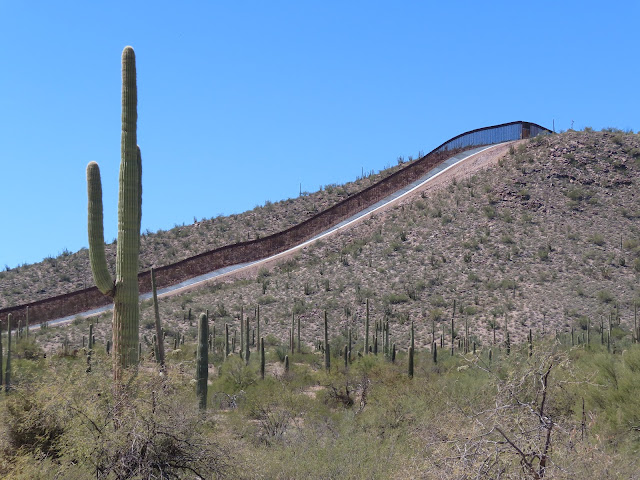Tucson Audubon Joins Dozens of Borderlands Conservation Organizations on Letter to President Biden
President Joseph R. Biden
The White House
1600 Pennsylvania Avenue
Washington, D.C. 20500
Dear Mr. President:
Congratulations on your historic victory. Already, your administration is bringing hope and decency to the pressing challenges facing our nation. Among these is the desperate situation along the U.S.-Mexico border, where inflamed rhetoric and misguided policies have led to unprecedented damage to the ecology, economy, and social fabric on both sides of the border. We stand with colleagues in conservation and humanitarian organizations who believe that a new approach is desperately needed, one that restores degraded lands and waters, respects the rights of indigenous people, protects the region’s unique wildlife and cultural heritage, and builds a sustainable economy on the foundation of a healthy natural environment.
In the face of the destruction wrought by construction of the ill-conceived border wall, ambitious efforts to restore degraded land and watersheds have already proven that damage can be reversed. Rapid action can mitigate the worst impacts of the border wall by reopening critical wildlife corridors, restoring riparian habitats, and healing the scars of construction before seasonal monsoon rains make the situation much worse.
We propose a three-part solution to the intertwined crises unfolding at the U.S.-Mexico border, which has been developed in consultation with a diverse group of regional conservation organizations and indigenous leaders. Taken together, these steps will signal an end to policies of neglect and abuse that elevated the construction of the border wall above the lives of residents and their environment. The recommendations, described in greater detail in the accompanying briefing paper, call on your administration to:
- Remove strategic segments of the border wall from sacred sites and critical wildlife crossing areas.
Many groups, backed by scientific analysis, are uniting in support of a priority list of sites developed by a coalition of conservation organizations in consultation with indigenous communities. Reopening these crucial migration corridors can be accomplished with a modest reallocation of previously authorized funds. If done swiftly, this action could mitigate negative impacts on wildlife and alleviate the suffering of indigenous communities divided by wall construction. - Restore riparian, riverine, and wetland habitats to protect and increase the resilience of water sources in the desert.
Conservation organizations and state, federal, and tribal agencies from both countries have decades of experience cooperating to restore degraded habitats, return surface waters, rebuild soils, and improve arid land for the benefit of both wildlife and agriculture. A comprehensive effort will require substantial planning and funding, but restoration can be jumpstarted with a $50-100M commitment to a competitive grants program for capacity building, training, and pilot projects that can be scaled up during the first year of your administration. - Foster restorative economic development through a Borderlands Restoration unit of your Civilian Climate Corps.
The borderlands experienced unacceptable poverty and unemployment rates even before the pandemic and the misguided policies of the Trump administration. A job corps program is desperately needed to provide living-wage jobs to the underemployed, particularly residents in transborder indigenous and rural communities. Such a program, funded by redirection of resources previously allocated for wall construction, should create a minimum of 2,000 jobs on each side of the border by 2022, with continued support over the coming decade. The program would serve as a model for the integration of ecosystem restoration and economic growth elsewhere, throughout the U.S. and Mexico.
 |
| The border wall cutting though Sonoran Desert habitat in Organ Pipe Cactus National Monument. Photo by Matt Griffiths |
In recent weeks, the undersigned have shared the attached document – a product of long-term and ongoing collaboration among U.S., Mexican, and indigenous leaders – with legislators and individuals involved in your transition teams and incoming leadership in multiple departments and agencies. Feedback has been very positive, and we believe cooperators are ready to pull together at multiple levels of government, in the private sector, and among the many humanitarian and environmental organizations who understand the borderlands and the intersecting challenges that must be addressed together.
We would be honored to discuss these ideas with you and your staff.
Respectfully yours,
The Honorable Bruce Babbitt
Former Secretary of Interior
The Honorable Sally Jewell
Former Secretary of Interior
Signatories
Richard Pritzlaff, President
Biophilia Foundation
Kurt Vaughn, Executive Director
Borderlands Restoration Network
Valer Clark, Founder
Cuenca de Los Ojos A.C.
Jeremiah H. Liebowitz, Executive Director
Cuenca Los Ojos
Kate Tirion, Founder
Deep Dirt Farm L.L.C.
Bryan Bird, Director of Southwest Office
Defenders of Wildlife, SW
Renée González, General Director
Fondo Mexicano para la Conservación de la Naturaleza, A.C.
Kate Scott, Director
Madrean Archipelago Wildlife Center
Oscar Moctezuma, Founder Director
Naturalia A.C.
Diana Hadley, Co-President
Northern Jaguar Project
Sergio Jimenez L., Executive Director
Organización Vida Silvestre A.C. (OVIS)
Alberto Lafon, Legal Representative
Profauna A.C.
Juan Ignacio Sada, Chairperson of the Board
Pronatura Noreste A.C.
Alan Hamilton, President
Rio Grande Return
Austin Nuñez, Chair
San Xavier District, Tohono O’odham Nation
Louise Misztal, Executive Director
Sky Island Alliance
Mike Zellner, Chief Executive Officer
Sonoran Institute
Kevin Bixby, Executive Director
Southwest Environmental Center
Lorenzo J. de Rosenzweig, Chairperson, Founder
Terra Habitus A.C.
Verlon Jose, Governor
Traditional O’odham Leaders
Jonathan Lutz, Executive Director
Tucson Audubon Society
India Aubrey, President
Voices from the Border
Katie Davis, Executive Director
Wildlands Network
Ron Pulliam, Co-Author, Managing Partner
Wildlife Corridors, L.L.C.
Thomas D. Sisk, Co-Author, Olajos-Goslow Chair
Northern Arizona University
Jennifer Gooden, Co-Author, Conservation Strategist
Biophilia Foundation, Cuenca Los Ojos
Comments
Post a Comment
Thanks, we value your opinions! Your comment will be reviewed before being published.